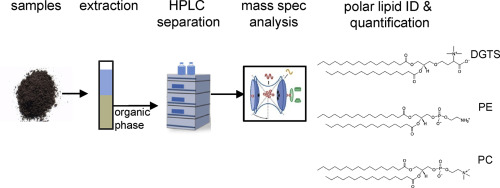Soil Biology and Biochemistry ( IF 9.8 ) Pub Date : 2019-11-04 , DOI: 10.1016/j.soilbio.2019.107655 Charles R. Warren

|
Soil microbes can be limited by phosphorus availability. A significant proportion of cellular P is accounted for by the phospholipids that comprise membranes. Experiments with aquatic microbial communities and isolated microbes have shown one way microbes can reduce their cellular P requirements is by substituting phospholipids with P-free polar lipids. We do not know if soil microbial communities can also spare P by using P-free lipids instead of phospholipids.
The aims of this study were to examine a range of contrasting soils and a) determine the profile of polar fatty-acid-based lipids; and b) examine if P-free polar lipids are more abundant in P-poor soils. To obtain a broad range in P availability we examined soils from 16 sites that encompassed a range of geologies and vegetation types. Intact lipids were identified and quantified using liquid-chromatography-mass spectrometry. An independent estimate of polar lipid classes was obtained by hydrolysing lipids and quantifying headgroups with capillary electrophoresis-mass spectrometry.
Among sites soil P status varied from supra-optimal (N:P = 2.4 g g−1) through to severely deficient (N:P = 80 g g−1). The dominant polar lipids among sites were phosphatidylethanolamine (PE), phosphatidylcholine (PC), and the betaine lipid diacylglyceryl-N,N,N-trimethylhomoserine (DGTS). Among sites as P availability declined a larger proportion of polar lipids was accounted for by betaine lipids such that in the most severely P-deficient soils phospholipids were only 61% of total polar lipids. If we assume that phospholipids account for one-third of cellular P, the measured substitution of phospholipids with betaine lipids would reduce the amount of P required for growth by around 10%. The substantial P saving due to lipid substitution could contribute to the selection of taxa under P deficiency.
中文翻译:

土壤微生物种群以低磷的可利用性用甜菜碱脂质替代磷脂
土壤微生物会受到磷的有效性的限制。细胞P的很大一部分是由构成膜的磷脂造成的。对水生微生物群落和分离的微生物进行的实验表明,微生物可以降低其细胞对P的需求的一种方法是用不含P的极性脂质代替磷脂。我们不知道土壤微生物群落是否也可以通过使用不含P的脂质代替磷脂来使P免受污染。
这项研究的目的是检查各种对比土壤,并a)确定基于极性脂肪酸的脂质的概况;b)检查贫磷土壤中无磷的极性脂质是否更为丰富。为了获得广泛的磷有效性,我们检查了16个地点的土壤,这些地点涵盖了一系列的地质和植被类型。使用液相色谱-质谱法鉴定和定量完整的脂质。极性脂质类别的独立估计是通过水解脂质并使用毛细管电泳-质谱法对头基进行定量来获得的。
在土壤位点中,土壤P的状态从最佳(N:P = 2.4 g g -1)到严重不足(N:P = 80 g g -1)。位点之间的主要极性脂质是磷脂酰乙醇胺(PE),磷脂酰胆碱(PC)和甜菜碱脂质二酰基甘油基-N,N,N-三甲基高丝氨酸(DGTS)。随着磷利用率的下降,甜菜碱类脂占极性脂类的比例更大,因此在最严重缺磷的土壤中,磷脂仅占总极性脂类的61%。如果我们假设磷脂占细胞P的三分之一,那么用甜菜碱类脂质测得的磷脂替代物将使生长所需的P量减少约10%。由于脂质取代而大量节省磷,可能有助于选择缺磷条件下的分类单元。











































 京公网安备 11010802027423号
京公网安备 11010802027423号